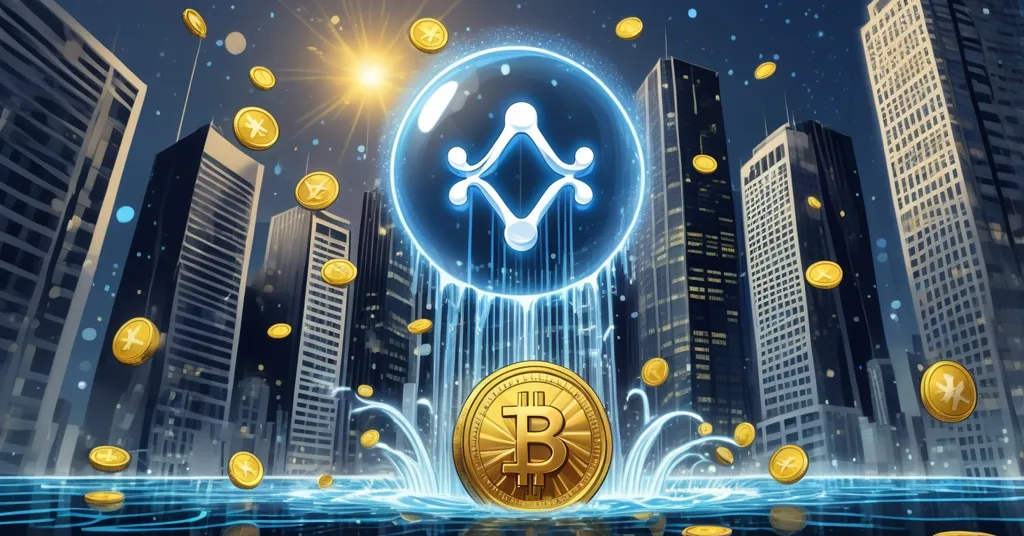$XRP ETFs Surge with $622M Inflows, Outshine Solana: Altcoin Boom or Bubble?

$XRP ETFs Smash Records with $622M Inflows, Outpace Solana: What’s Next for Altcoins?
A seismic shift is rocking the cryptocurrency market as $XRP ETFs have raked in an eye-popping $622 million in just eight trading days, leaving Solana in the rearview mirror and marking Ripple’s token as the top altcoin for institutional capital. This surge signals a broader rotation of investment away from Bitcoin and Ethereum dominance, raising questions about where the altcoin market is headed—and whether this is a sign of maturity or just another speculative bubble waiting to burst.
- $XRP ETF Boom: $622M in inflows within eight days, overtaking Solana as the leading altcoin ETF product.
- Institutional Muscle: Franklin Templeton and Grayscale inject $62M and $67M respectively in a single day.
- Altcoin Dilemma: Balancing $XRP’s proven utility against speculative presale projects in a frothy market.
$XRP ETFs Steal the Spotlight: Breaking Down the Numbers
The numbers don’t lie: $XRP has pulled in over $622 million through Exchange-Traded Funds (ETFs) in a mere eight trading days, a staggering feat that has outstripped Solana’s ETF performance and solidified its status as the altcoin of choice for institutional investors. For those new to the game, ETFs are investment vehicles traded on traditional stock exchanges, allowing big players to gain exposure to crypto without directly holding the assets—a bridge between Wall Street and the wild world of blockchain. Heavy hitters like Franklin Templeton and Grayscale have fueled this fire, dumping $62 million and $67 million respectively into $XRP ETFs in just one day. The market has responded with a price bump, pushing $XRP to a recent high of $2.23 from below $2.20, though it’s currently hovering around $2.17 on platforms like Binance.
Behind this momentum is $XRP’s core tech, built on the XRP Ledger—a blockchain engineered for speed and efficiency. Transactions settle in 3 to 5 seconds with fees so tiny they’re barely worth mentioning, making it a darling for cross-border payments where legacy systems like SWIFT can take days and charge hefty sums. Financial institutions have taken notice, integrating $XRP into their systems as a way to move money across borders without the usual friction. This isn’t just hype; it’s a real-world use case that sets $XRP apart from many altcoins peddling empty promises.
Why Institutions Are Betting Big on Ripple’s Tech—And Why It’s Not All Roses
The institutional rush into $XRP isn’t happening in a vacuum. Ripple, the company behind $XRP, has spent years battling regulatory headwinds, most notably a high-profile lawsuit with the U.S. Securities and Exchange Commission (SEC) launched in 2020 over whether $XRP qualifies as a security. Recent legal wins and growing clarity have likely emboldened firms like Franklin Templeton to jump in, seeing $XRP as a safer bet among altcoins. This ETF surge mirrors the trend we’ve seen with Bitcoin and Ethereum ETFs, where institutional money—think billions since Bitcoin ETF approvals in early 2023—has poured into crypto, seeking diversified exposure beyond the top two coins.
But let’s pump the brakes on the cheerleading. As much as we champion disruption of traditional finance, $XRP’s cozy relationship with institutions raises red flags for decentralization purists. Ripple holds a significant chunk of the total $XRP supply, a centralized control point that clashes with the ethos of crypto as a permissionless, trustless system. Is this institutional embrace a stepping stone to mass adoption, or does it risk turning $XRP into just another cog in the TradFi machine? As Bitcoin maximalists, we can’t help but squint at anything that smells of centralization—Bitcoin’s uncompromised sovereignty remains the gold standard, even if $XRP’s utility in payments tackles a niche Bitcoin doesn’t touch.
Altcoin Mania: The Risky Rise of Presale Tokens
While $XRP basks in institutional glory, the altcoin market is also bubbling with speculative fervor—think presale tokens promising the moon but often delivering a crater. For the uninitiated, presales are early investment rounds before a token hits public exchanges, typically marketed with dirt-cheap prices and eye-watering rewards to lure retail investors. Two projects catching buzz right now are $PEPENODE and $SUBBD, but let’s cut through the noise and see if there’s any substance behind the shiny wrappers.
First, $PEPENODE, an Ethereum-based meme coin with a “mine-to-earn” gimmick. Unlike Bitcoin mining, which requires energy-guzzling hardware, $PEPENODE offers virtual mining nodes—essentially a gamified way to earn tokens without breaking a sweat. It’s raised $2.2 million in presale with a staggering staking reward rate of 587% annually. Sounds sexy, right? More like a siren call for your wallet to walk the plank. Such yields are unsustainable nonsense, often used as bait to hook naive investors. Meme coins, by nature, are driven by hype and community fervor—think Dogecoin’s Shiba Inu mascot—but lack real utility. History shows most fizzle out or, worse, turn into rug pulls where developers vanish with the cash. If you’re tempted, remember: this is gambling, not investing.
Then there’s $SUBBD, a project targeting the $85 billion content creation industry with Web3 and AI tools. Web3, in simple terms, is the vision of a decentralized internet built on blockchain, where users own their data instead of Big Tech overlords. $SUBBD aims to empower creators—think YouTubers or artists—with on-chain payments and tech to streamline production. It’s pulled in over $1.3 million in presale with a more reasonable staking yield of 20% for the first year. The idea has potential; the creator economy is ripe for disruption. But let’s not kid ourselves—delivering on such promises is a long shot. Most presale projects flop due to execution failures or outright scams. Back in the 2017-2018 ICO craze, over 80% of projects failed to deliver anything meaningful. $SUBBD might be a diamond in the rough, but odds are it’s just another shiny rock.
Balancing Hype and Reality in the Altcoin Market
Zooming out, the $XRP ETF boom reflects a fascinating dichotomy in the altcoin space. On one side, institutional money is flowing into battle-proven projects with tangible value like $XRP, hinting at a maturing market that craves stability over moonshot dreams. On the other, retail investors are diving into speculative presales like $PEPENODE and $SUBBD, chasing asymmetric gains in what’s shaping up to be a classic altcoin cycle driven by FOMO—fear of missing out. It’s the same old story: after Bitcoin rallies, capital trickles down to riskier plays, often with disastrous results for the latecomers. For insights into other promising altcoins amidst this $XRP ETF dominance, check out this guide on top altcoin picks.
As advocates of effective accelerationism, we’re all for pushing innovation at breakneck speed—let a thousand experiments bloom, even if 90% crash and burn. Altcoins play a vital role in this financial revolution, testing ideas Bitcoin doesn’t cover. Ethereum brought smart contracts; Solana chases scalability; $XRP bridges traditional and decentralized finance. Even meme coins, for all their absurdity, test the bounds of community-driven value. But let’s not drink the Kool-Aid on every half-baked token. Bitcoin remains the unassailable king of decentralization and store of value, the hill we’d die on. Altcoins can complement that mission, but they’re not replacements—and certainly not when they’re little more than marketing scams dressed as innovation.
So where do you place your bets? If you’re looking for a lower-risk play with upside, $XRP’s momentum and real-world adoption make it a standout, despite its centralization quirks. If you’ve got a stomach for volatility and a penchant for rolling the dice, presale tokens might scratch that itch—just don’t bet the farm. The crypto space is a minefield of opportunity and snake oil, and for every genuine disruptor, there’s a con artist waiting to fleece the unwary. We’re rooting for a decentralized future where innovation thrives, but let’s keep our eyes peeled—hype is a hell of a drug, and not every project is destined to rewrite the rules.
Key Takeaways and Burning Questions
- What’s fueling the $622 million surge into $XRP ETFs?
Institutional giants like Franklin Templeton and Grayscale are backing $XRP’s proven utility in cross-border payments, seeing it as a stable altcoin bet amid a shift beyond Bitcoin and Ethereum. - How does $XRP’s tech give it an edge over traditional systems?
Operating on the XRP Ledger, it enables near-instant transactions (3-5 seconds) with negligible fees, outpacing slow, expensive legacy systems like SWIFT in international money transfers. - Are presale tokens like $PEPENODE and $SUBBD safe investments?
Hell no. They’re high-risk gambles with unproven models, often plagued by unsustainable promises and a history of scams—approach with extreme caution or not at all. - Does $XRP’s institutional adoption undermine decentralization?
Partially. While it drives mainstream uptake, Ripple’s control over much of the token supply raises valid concerns about centralization, clashing with crypto’s core ethos. - How should investors navigate the altcoin frenzy?
Prioritize projects with real utility like $XRP for safer exposure, and steer clear of speculative hype unless you’re prepared to lose it all—most altcoins won’t survive the hype cycle.



